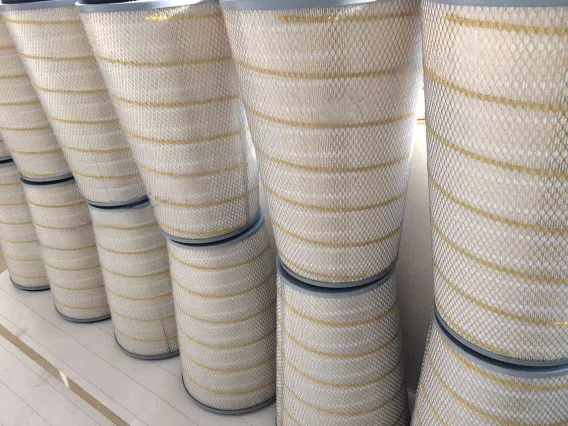 Tel:
+8615930870079
Tel:
+8615930870079
Dec . 04, 2024 09:39 Back to list
Exploring the Benefits and Applications of Cartridge Air Filters in Modern Systems
Understanding Cartridge Filter Air Systems
Cartridge filter air systems play a crucial role in various industries, providing clean air by efficiently removing contaminants, dust, and other pollutants from the air. These filters serve multiple applications, including manufacturing facilities, HVAC systems, and industrial processes. In this article, we will explore the mechanics of cartridge filters, their advantages, selection criteria, and maintenance to ensure optimal performance.
What is a Cartridge Filter?
A cartridge filter is a type of air filtration system that utilizes a cylindrical filter element, typically made of pleated synthetic materials or fiberglass, to capture airborne particles and pollutants. The design promotes a high surface area, allowing for greater efficiency in trapping contaminants. As the air passes through the filter, particles are trapped on the surface, while clean air continues to flow through.
How Do Cartridge Filters Work?
The operation of a cartridge filter is fairly straightforward. Contaminated air is drawn into the system, where it encounters the filter media. The design of the pleats creates a large surface area, increasing the amount of air that can be filtered without causing excessive pressure drop. As air moves through the cartridge, particles are collected, and clean air is released into the environment or directed back into the system. Over time, the filter becomes saturated with pollutants, necessitating cleaning or replacement.
Advantages of Cartridge Filter Air Systems
1. High Efficiency Cartridge filters are known for their superior filtration capabilities, capable of capturing particles as small as 0.3 microns. This high level of efficiency ensures that the air is purified effectively, reducing the risk of respiratory issues and improving overall air quality.
2. Compact Design The cylindrical shape and pleated design of cartridge filters allow them to fit into more compact spaces compared to traditional filter formats. This makes them ideal for applications where space is limited while still requiring effective filtration.
3. Cost-Effectiveness Although the initial investment may be higher than other filter types, cartridge filters tend to have lower operational and maintenance costs over time. Their longer service life and reduced need for frequent replacements contribute to overall cost savings.
4. Versatility Cartridge filters can be tailored to meet specific application needs, including different filtration grades and materials. This versatility allows them to be used in various sectors, such as pharmaceuticals, food processing, and automotive.
5. Low Pressure Drop Due to their design, cartridge filters maintain a lower pressure drop, resulting in reduced energy consumption for air handling systems. This efficiency translates to lower operational costs and a smaller carbon footprint.
cartridge filter air

Selective Criteria for Cartridge Filters
When selecting a cartridge filter, several factors should be considered to ensure it meets the requirements of the application
1. Particle Size Understand the types and sizes of particles that need to be filtered. Graded filters may be necessary for specific industrial processes.
2. Airflow Requirements Assess the airflow rate required for your application. Ensure that the chosen filter can accommodate the necessary volume without creating excessive pressure drop.
3. Environmental Considerations Consider the operating environment, including temperature and humidity levels, which can influence filter performance and material choice.
4. Service Life and Maintenance Evaluate the expected lifespan of the cartridge filter and plan for regular maintenance schedules to ensure consistent performance.
Maintenance of Cartridge Filters
To maximize the efficiency and longevity of cartridge filters, regular maintenance is essential. This includes
1. Inspection Conduct routine checks for visible dirt accumulation and any potential damage to the filters.
2. Cleaning For reusable filters, implement an appropriate cleaning method, such as compressed air or washing, to remove accumulated dust without damaging the filter media.
3. Replacement Follow the manufacturer's recommendations on replacement intervals to prevent reduced air quality and inefficient operation.
In conclusion, cartridge filter air systems are an integral component of modern filtration technology. Their efficiency, compactness, and versatility make them suitable for various applications while ensuring high air quality. By understanding their operation, benefits, and maintenance requirements, industries can effectively harness the power of cartridge filters to create cleaner and healthier environments.
-
Nano Fiber Technology: Revolutionizing Cartridge Dust Collector FiltersNewsAug.06,2025
-
How Activated Carbon Air Cartridges Eliminate OdorsNewsAug.06,2025
-
Dust Filter Cartridge Handling Fine Particulate MatterNewsAug.06,2025
-
Cartridge Dust Collector Filter for Welding Fume ExtractionNewsAug.06,2025
-
Activated Carbon Filter Cartridge Effectiveness Against VOCsNewsAug.06,2025
-
Activated Carbon Air Filter Cartridge Benefits ExplainedNewsAug.06,2025

 Email:
Email:





